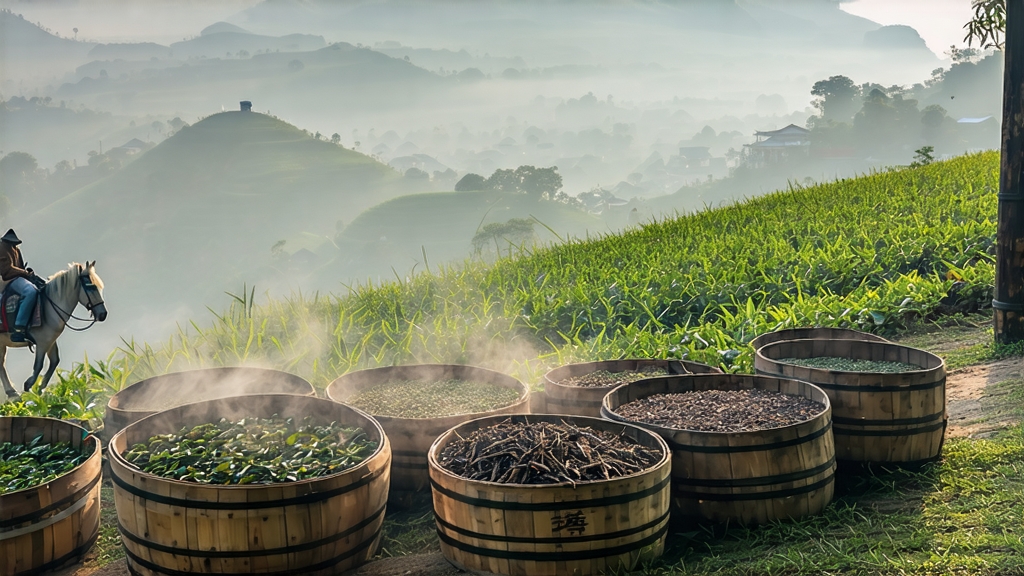
Tucked away in the humid, karst-pocked mountains of southern China’s Guangxi Zhuang Autonomous Region, Liu Bao tea has spent four centuries quietly perfecting the art of transformation. While Pu-erh commands global headlines, Liu Bao—literally “Six Forts,” named after the six stockade villages that once protected the tea trade—remains the connoisseur’s whispered secret, a dark tea whose mellow, betel-nut sweetness once fueled caravans on the 2,000-kilometre Tea Horse Road to Southeast Asia. Today its mellow liquor is re-emerging on specialty menus from Berlin to Melbourne, carrying with it the microflora of Guangxi’s evergreen forests and the patience of artisans who still speak of “tea breathing” as if it were a living creature.
History: From Frontier Currency to Maritime Gold
Liu Bao’s documented story begins in the late Ming dynasty (c. 1600 CE) when imperial troops stationed along the Guangxi-Guangdong border bartered compressed tea bricks for supplies. The humid climate made green tea spoil within weeks, so soldiers learned to heap the leaves in bamboo baskets, allowing latent yeasts and bacteria to ferment the tea into a stable, lightweight currency. By the Qing Qianlong era (1736–1795), Liu Bao had become a tribute item shipped down the Xun River to the port of Wuzhou, then loaded onto junks that crossed the South China Sea to Malacca, where it was exchanged for pepper, tin and nutmeg. Colonial medical officers in British Malaya even listed “Lieu-pak” as a remedy for dysentery, noting that Indian and Malay dockworkers drank it sweetened with palm sugar to counter “tropical fatigue.” After the 1949 founding of the People’s Republic, state trading corporations standardised production, but the Cultural Revolution (1966–1976) disrupted private cellars; many 1950s “Zhong Cha” branded Liu Bao cakes survived only in overseas Chinese kitchens, where grandmothers used them to rinse greasy woks, unaware that the earthy aroma rising from hot iron was worth its weight in silver decades later.
Micro-terroirs within Six Forts
Modern Liu Bao is divided into three micro-origins, each offering a distinct microbial signature. The highest elevation is Tangping, a misty ridge at 800 m where wild camellia sinensis var. assamica grows beneath towering cinnamon trees; teas from here carry a cooling camphor note reminiscent of old Chinese medicine chests. Mid-slope Xiali village produces the classic “betel-nose” profile—fermented leaves pressed in betel leaf parcels for local chewers, impregnating the tea with a subtle peppery lift. Lowest and warmest is Dazhushan, whose iron-rich red soil nurtures darker, thicker leaves that yield a silky, date-sweet liquor favoured by Hong Kong tea merchants for “dim sum pairing.” Within each zone, single-garden lots are further coded by the year of wet-piling and the bamboo basket maker’s initials—calligraphic marks that connoisseurs decode like Burgundy climats.
Craft: The Living Basket
Unlike Pu-erh’s wodui (piling on cement floors), Liu Bao’s “rè fā” (heat-fermentation) happens inside woven bamboo baskets lined with large-leaf tea. Fresh leaves are kill-green at 200 °C for three minutes to rupture cells, then rolled until they “sweat” a jade-green juice. The crucial step is the 7–10 day basket pile: 60 kg portions are stacked in a steamy 28 °C room where indigenous Bacillus subtilis and Aspergillus niger bloom, raising internal temperature to 45 °C. Every 48 hours the tea master—“basket-turner” in local dialect—inserts a long bamboo pole to aerate the core, a ritual accompanied by drum-like thuds that echo through the warehouse. Once the leaf edges turn chestnut-brown and emit a scent of damp forest floor, the tea is sun-dried on raised bamboo racks, then moved to underground cellars built into karst caves where relative humidity hovers at 85 %. Here it enters the “Chen hua” (slow aging) phase, a minimum of three years but ideally fifteen, during which melanoidins deepen and a rare polyketide called theabrown